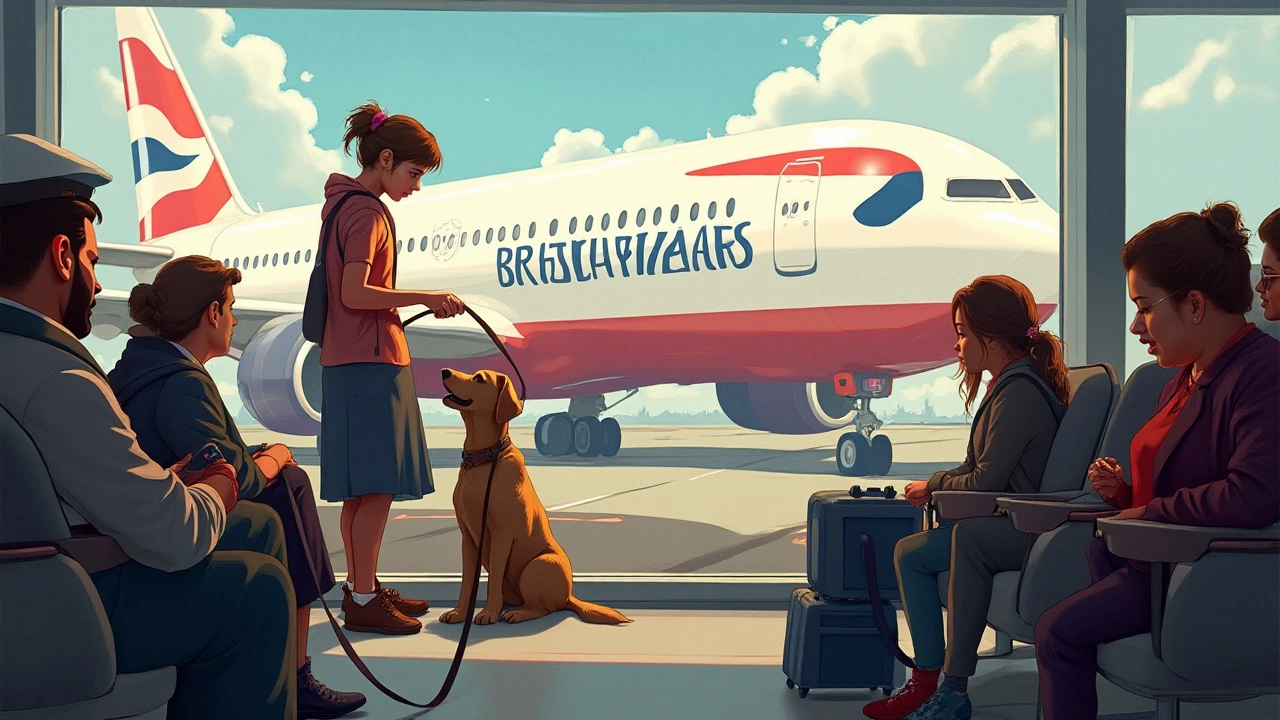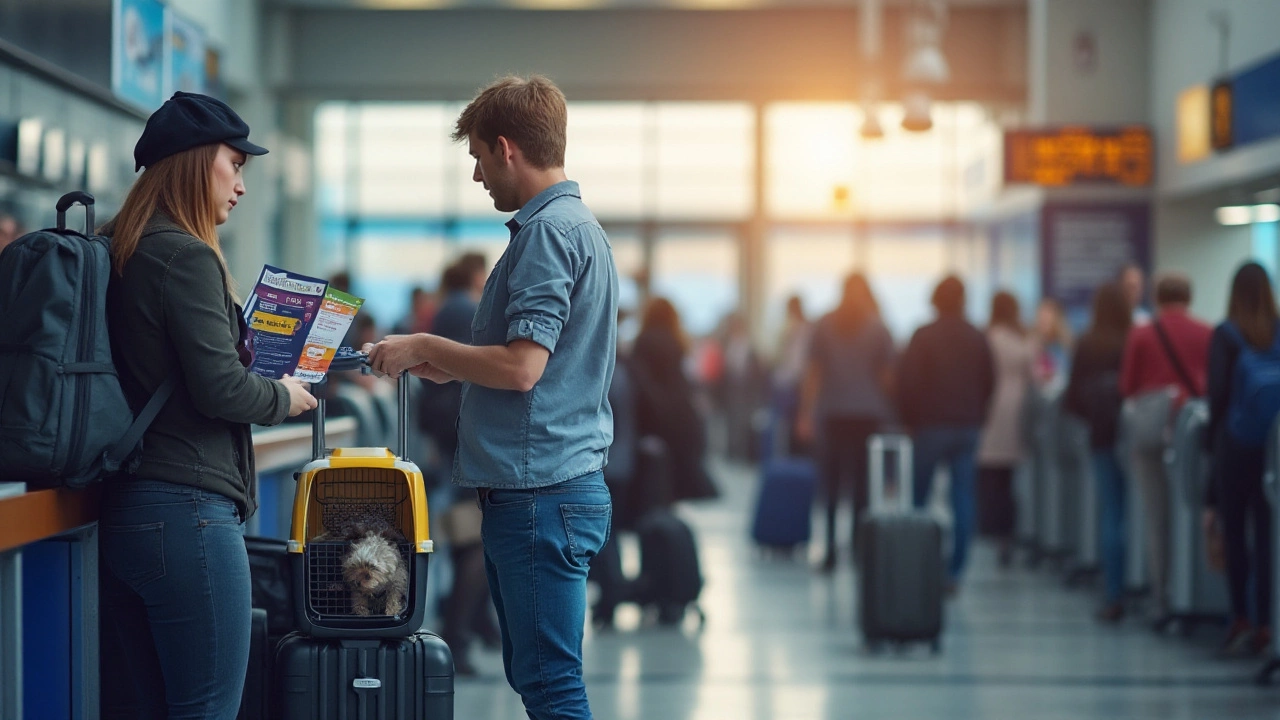Flying with pets is not a straightforward endeavor. There's a tangled web of rules and regulations that airlines have regarding the furry members of your family. For pet owners, it becomes crucial to know which airlines have restrictions on bringing pets aboard.
Not all airlines roll out the red carpet for animals, and some prefer to keep their cabins pet-free due to various reasons like allergies, safety, and space limitations. But don't worry; there are several ways to tackle this challenge if you plan to soar through the skies with your pet by your side.
In this article, we'll dive into the world of airline pet policies, uncovering which carriers firmly say no to pets. We'll also explore some tips on ensuring a hassle-free journey for both you and your beloved companion.
- Understanding Airline Pet Policies
- Airlines with No Pets Allowed
- Changes in Pet Travel Regulations
- Impact on Pet Owners
- How to Travel with Pets Safely
- Alternatives to Flying with Pets
Understanding Airline Pet Policies
Airline pet policies can seem as intricate as a tapestry, filled with threads that need careful attention. It's essential for pet owners to comprehend these regulations before they embark on their journeys. When it comes to pet travel, airlines typically differentiate between cabin travel and cargo travel. Some airlines allow small pets to travel in the cabin, provided they fit comfortably in an airline-approved carrier under the seat in front of you. Larger pets or those that do not comply with cabin regulations are usually consigned to the cargo hold, where conditions differ significantly from the cabin environment. This differentiation in pet policy is rooted in maintaining comfort and safety for both passengers and pets.
On the surface, each airline appears to have its unique set of rules regarding pets, but many of them align on similar overarching principles. Factors such as the pet's size, type (whether it is a cat or a dog), and even breed can impact the decision. Breeds considered to be "high-risk," such as brachycephalic or "snub-nosed" dogs and cats, might face restrictions due to their susceptibility to respiratory issues, especially at high altitudes. Airlines like Southwest, for example, have specific guidelines that prevent such breeds from flying. Understanding these classifications and requirements can make a world of difference when planning a trip.
The necessity for these rules isn't merely arbitrary. According to the American Veterinary Medical Association, there's a growing emphasis on ensuring the welfare and safety of pets in transit.
"When considering pet travel, it's vital to research the specific requirements and safety measures established by your chosen airline," says Alice Ford, a spokesperson for Pet Travel Safety Association. "Ensuring a safe and comfortable environment for pets isn't just a recommendation – it's a requirement."This sentiment is echoed across the industry, promoting awareness about adequate preparation before traveling with pets.
Another interesting facet is the regional variance in pet travel policies. For instance, in some European airlines, emotional support animals are treated differently than on their American counterparts. The shift in regulations, especially after 2021, saw a decline in airlines recognizing emotional support animals as service animals, whereas some international carriers maintain distinctions that can affect booking. Thus, understanding individual airline rules is paramount.
Staying informed about these policies not only aids in selecting the right airline but ensures that pet owners can avoid last-minute hiccups at the airport. For example, documenting the necessary vaccinations and health certificates might sound routine, but such documentation is a crucial requirement for airlines that welcome pets. An understanding of each airline’s specific checklist can save a traveler both time and potential disappointment. Moreover, engaging with the airline before travel – speaking directly with customer service representatives – is sometimes the best way to clarify murky details and solidify understanding.
Airlines with No Pets Allowed
Not every airline is pet-friendly, and some impose strict rules against allowing pets on board. While it may be disappointing for pet owners, these policies are often put in place for valid reasons—namely, the safety and comfort of all passengers. When planning your next trip, it's essential to know which airlines do not allow pets.
Starting with Asian carriers, many traditional airlines in this region have a more conservative stance on pet travel. For instance, China Southern Airlines, one of the largest carriers in Asia, traditionally does not allow pets in the cabin, though they provide cargo hold services under specific conditions. Concerns about allergies, potential health risks, and the airline's infrastructure drive this restriction.
In the Middle East, Saudi Arabian Airlines also restricts pets in the cabin. These airlines operate under strict guidelines that align with cultural practices where pet travel might not be as widely accepted as in some Western countries. Cabin space is another consideration, as many international flights are long-haul, which complicates pet accommodation logistics.
An interesting fact about some European low-cost carriers, like Ryanair and Wizz Air, is their firm stance on not allowing pets onboard. Their model focuses on quick turnarounds and budget-friendly solutions that typically avoid the complications of accommodating pets. Although this may seem harsh, their operational model focuses on efficiency and cost-reduction, leaving little room for pet passengers. A Raynair spokesperson once mentioned, "Our quick service and limited cabin space doesn't quite suit pet travel demands, and we like to keep our flights hassle-free for all customers."
Understanding these restrictions can greatly affect your travel plans, especially if you are accustomed to bringing your pet along on your journeys. One important detail to note is that many airlines that do not allow pets in the cabin might still offer cargo transport. However, this method may not be suitable for all animals, particularly those with health issues.
If we're talking numbers, a survey from 2023 suggests approximately 15% of airlines worldwide have outright bans on pets traveling in the cabin. Here's a concise breakdown to give a clearer picture:
| Region | Percentage of Airlines with Pet Restrictions |
|---|---|
| Asia | 20% |
| Middle East | 18% |
| Europe | 12% |
This data underscores the significance of researching each airline's pet policy before booking your tickets. Preparing in advance helps to ensure a smooth journey for both you and your animal companion, preventing unpleasant surprises at the airport. Ultimately, it's about choosing the right airline that meets your needs while observing their protocols for a seamless travel experience.

Changes in Pet Travel Regulations
Not so long ago, pet travel regulations were more relaxed, allowing a broader range of species to board flights with minimal fuss. However, as the global travel landscape evolved, so too did the rules around flying with our fur family. One of the main reasons for these changes is the increased concern over animal welfare during long-haul flights and the various risks involved, such as health implications for both pets and fellow passengers. Airlines have become more conscious of the aviation environment contributing significantly to how they shape their policies regarding pet travel.
A notable shift has been the implementation of stricter guidelines related to in-cabin pet travel. Historically, smaller pets could effortlessly accompany their owners in the cabin, nestled under the seat or within the passenger’s travel bag. But with heightened awareness about allergies and limited space to ensure safety during air turbulence, many airlines have either limited or canceled such concessions. Some airlines allow pet travel only for service animals, adhering to more rigorous definitions of what constitutes a service animal. For example, Delta Airlines now requires all service animals to be specially trained for specific disabilities, moving away from acknowledging emotional support animals.
Airlines that permit pets have instituted stringent documentation protocols. This may involve extensive vaccination records, microchip details, and in some cases, a period of pre-flight quarantine. This shift has been partly driven by national regulations, like the European Union's Pet Travel Scheme (PETS), which outlines detailed procedures for pet travel in and out of the EU. Travelers must now plan significantly in advance to meet these standards. According to the International Air Transport Association, over 50% of airlines worldwide have adopted a uniform health and safety standard for pet travel, ensuring better conditions for animals in transit.
| Year | Regulation Changes |
|---|---|
| 2023 | Limit on Emotional Support Animals Per Cabin |
| 2024 | Mandatory Vaccination Records and Microchipping |
These changes mean that passengers need to be more mindful. One might hear fellow travelers express concern over ever-increasing paperwork and restrictions making the process seem daunting. Yet these regulations intend to enhance the safety and comfort of both animals and passengers. Potential pet travelers should conduct comprehensive research on their chosen airlines well in advance, often discovering myriad details through online forums and airline customer service. By staying informed, travelers can make informed decisions, ensuring that their next flight with a beloved pet proceeds without any hitches.
Impact on Pet Owners
The restrictive airline policies on pet travel can have profound consequences for pet owners, especially those who consider their pets as important as family members. For individuals who need to travel, either for leisure or other unavoidable commitments, understanding these restrictions may be quite frustrating. Imagine planning a vacation or a business trip only to find out at the last minute that your trusted airline does not accept pets on board. Such scenarios can lead to increased stress and anxiety, not only for people but also for the animals.
These restrictions can also be financially taxing. Pet owners may find themselves looking into alternative travel arrangements, which usually prove more costly, whether that involves booking special pet transport services or arranging a long road trip when flying is no longer an option. The search for pet-friendly airlines might extend travel planning times. Even the available airlines that do permit pets often come with a mountain of rules and hidden fees, which pet owners must navigate carefully.
Moreover, separating pets from their owners, especially for extended periods, is more than a logistical issue; it can affect their mental well-being. Pets often associate comfort and security with being close to their human companions, and an unsettling travel experience can lead to behavioral issues like anxiety, excessive barking, or aggression. As the pet travel sector grows, people seek reliable, stress-free ways to bring their beloved animals with them. In this regard, airlines with strict no-pet policies might be seen as less accommodating by modern standards.
Challenges Posed by No-Pet Policies
When airlines prohibit pets, pet owners are forced to look at other costly and complex relocation methods. Long-distance driving, chartering a pet-friendly flight, or leaving the pet at a boarding facility are not always optimal choices and might lean heavily on family budgets. Many travelers also express concerns over their pet's safety during alternative transport methods, spurred by fear of the unknown and reluctance to entrust their pets' well-being to a third party.
"Given the challenges we face during air travels with our pets, it becomes crucial for pet owners to thoroughly research and prepare, especially if the airline bans in-flight pets," advises Tom Hervey, a transport expert from the American Society for the Prevention of Cruelty to Animals (ASPCA).
In some cases, the impact extends beyond inconvenience. It touches upon health concerns and the emotional toll on both pet and owner. With an ever-growing number of individuals adopting pets, this situation underscores a vital discussion about integrating pets into air travel with more consideration, aiming for a balance between safety and accessibility. By understanding the broader implications of not permitting pets, airlines might find untapped potential in the developing pet travel niche.

How to Travel with Pets Safely
Traveling with your pet can be an enriching experience, but for it to be a smooth ride, there are several factors you need to consider. First and foremost, anticipate your pet’s needs just like you would for any other travel companion. Before taking off, make sure to visit your veterinarian to ensure your pet is in good health and fit to fly. Obtaining a health certificate is often required for air travel, indicating your pet is up-to-date on vaccinations. Knowing your pet’s temperament is vital; some animals may find the hustle and bustle of airports stressful. If you're unsure how your pet might react, it might be wise to start with short trips to see how they handle the environment.
Choosing an airline that is pet-friendly is crucial. While many have embraced pet travel, there are still some that do not allow pets in-cabin. It's essential to confirm these details in advance so there are no surprises at the check-in counter. Once you've booked with an accommodating airline, familiarize yourself with their pet travel policies—each has its own set of rules regarding carriers, weight, and breed restrictions. Do not overlook these details, as they could make or break your travel experience. Providing your pet a sturdy, comfortable carrier that's well-ventilated and secure is a non-negotiable part of preparation.
Another important aspect is feeding and hydration. Make sure your pet is both hydrated and fed but allow a gap of a few hours before your flight, as this can minimize motion sickness and ensure they're comfortable during the journey. It's smart to pack a bag specifically for your pet. Items such as their favorite toy, a blanket, food, waste bags, and collapsible water bowls can make their journey more pleasant. Just as you would with a young child, these familiar items can be comforting and provide reassurance.
According to a study by the American Veterinary Medical Association, "Proper mental and physical preparation can greatly reduce stress for both pet and owner during air travel."
If you have a longer flight, be ready for layovers. Some airports have dedicated pet relief areas—knowing where these are located in advance can be hugely helpful. These areas provide a necessary break for both pets and their owners, giving them space to relax and stretch out. During the flight, keep a calm demeanor as pets often pick up on their owner’s emotions. This helps in keeping your pet travel stress-free and enjoyable.
Returning home after your travels, routine checks post-travel are necessary; ensure your pet hasn’t picked up any unwelcome souvenirs like fleas or ticks. A brief visit or call to the vet on your return might just help catch anything unwanted early. If you're using a microchip or ID tag, ensure your details are current. Emergencies can happen at any time, and having the correct information can make all the difference in immediate reunions after travel adventures.
Taking these measures into account ensures not only the safety of your pet during travel but also enriches the entire experience. Adhering to these guidelines diligently reduces possible stress and anxiety, paving the path for more journeys with your beloved companion.
Alternatives to Flying with Pets
If your chosen airline doesn’t allow pets or if flying is simply not an option, you might find yourself contemplating other modes of travel that are more accommodating for your furry companion. Fortunately, there are several alternatives that can help ensure both safety and comfort for your pet.
One of the most popular options is traveling by car. This method gives you complete control over your pet’s environment. You can make stops for exercise and bathroom breaks, which can be crucial for reducing stress. It’s important to plan your route, ensuring there are pet-friendly hotels along the way. Equally crucial is preparing your car for the journey. Using a pet seatbelt or travel crate can prevent distractions and keep your pet secure. It’s worth noting that over 60% of pet owners prefer driving due to the flexibility it offers.
For shorter distances, trains and buses often provide a feasible solution. Some train services, like Amtrak, allow small pets on board for an additional fee. Policies differ, so it's vital to check in advance. When traveling by bus, explore if there are any pet-friendly services. Greyhound, for example, typically doesn't allow pets, except service animals. Always verify these rules ahead of your journey to avoid unnecessary surprises.
Hiring a pet transport service is another viable option. These services specialize in safely transporting animals and often cater to both domestic and international travel. They handle many of the logistics, from providing appropriate crates to dealing with customs. Selecting a reputable company is essential, so seek out reviews and recommendations. Utilizing a pet transport service can significantly ease the stress of logistics and ensure professional care for your animal companion.
In some cases, choosing not to travel with your pet might be the best decision. Consider engaging a professional pet-sitting service or boarding facility as an alternative. Many pet owners find peace of mind knowing their animals are safe in a familiar environment or under the care of experienced professionals while they’re away. Some sitters offer live video updates and regular communication, which can ease anxieties about separation.
It's clear that while flying might be the quickest way to your destination, it’s certainly not the only way to travel with pets. With prior planning and understanding of available options, you can make informed decisions that prioritize your pet’s safety and well-being.
"The journey of pet travel can vary greatly in complexity depending on the chosen mode of transport. Understanding your pet’s needs and the options available is key," says Amelia Jennings, a pet travel advisor with over a decade of experience.
